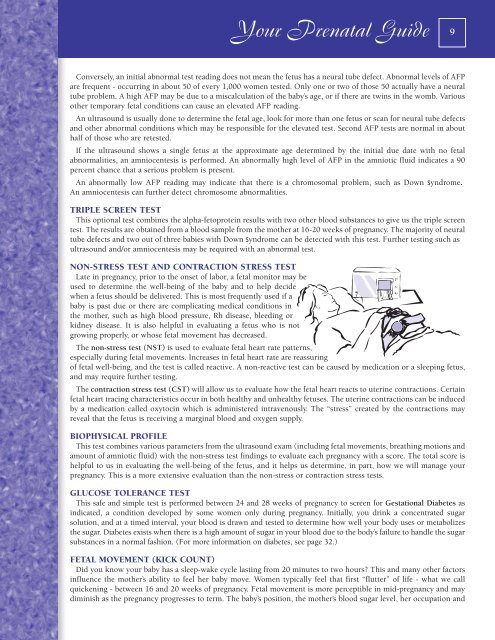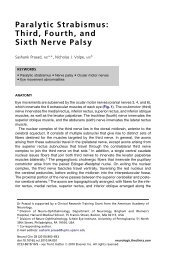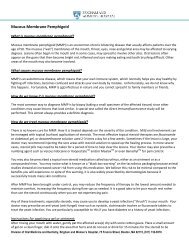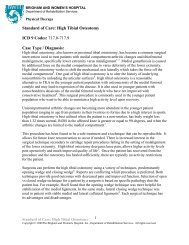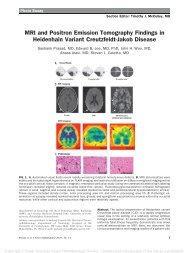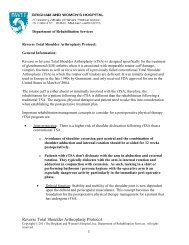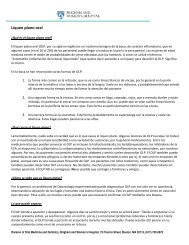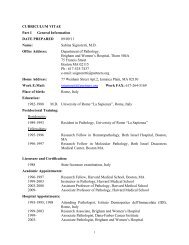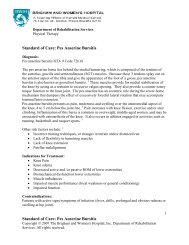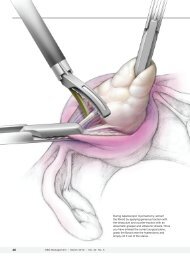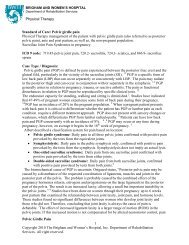Enjoying Your Pregnancy Guide to Understanding - Brigham and ...
Enjoying Your Pregnancy Guide to Understanding - Brigham and ...
Enjoying Your Pregnancy Guide to Understanding - Brigham and ...
You also want an ePaper? Increase the reach of your titles
YUMPU automatically turns print PDFs into web optimized ePapers that Google loves.
<strong>Your</strong> Prenatal <strong>Guide</strong> 9<br />
Conversely, an initial abnormal test reading does not mean the fetus has a neural tube defect. Abnormal levels of AFP<br />
are frequent - occurring in about 50 of every 1,000 women tested. Only one or two of those 50 actually have a neural<br />
tube problem. A high AFP may be due <strong>to</strong> a miscalculation of the baby’s age, or if there are twins in the womb. Various<br />
other temporary fetal conditions can cause an elevated AFP reading.<br />
An ultrasound is usually done <strong>to</strong> determine the fetal age, look for more than one fetus or scan for neural tube defects<br />
<strong>and</strong> other abnormal conditions which may be responsible for the elevated test. Second AFP tests are normal in about<br />
half of those who are retested.<br />
If the ultrasound shows a single fetus at the approximate age determined by the initial due date with no fetal<br />
abnormalities, an amniocentesis is performed. An abnormally high level of AFP in the amniotic fluid indicates a 90<br />
percent chance that a serious problem is present.<br />
An abnormally low AFP reading may indicate that there is a chromosomal problem, such as Down syndrome.<br />
An amniocentesis can further detect chromosome abnormalities.<br />
TRIPLE SCREEN TEST<br />
This optional test combines the alpha-fe<strong>to</strong>protein results with two other blood substances <strong>to</strong> give us the triple screen<br />
test. The results are obtained from a blood sample from the mother at 16-20 weeks of pregnancy. The majority of neural<br />
tube defects <strong>and</strong> two out of three babies with Down syndrome can be detected with this test. Further testing such as<br />
ultrasound <strong>and</strong>/or amniocentesis may be required with an abnormal test.<br />
NON-STRESS TEST AND CONTRACTION STRESS TEST<br />
Late in pregnancy, prior <strong>to</strong> the onset of labor, a fetal moni<strong>to</strong>r may be<br />
used <strong>to</strong> determine the well-being of the baby <strong>and</strong> <strong>to</strong> help decide<br />
when a fetus should be delivered. This is most frequently used if a<br />
baby is past due or there are complicating medical conditions in<br />
the mother, such as high blood pressure, Rh disease, bleeding or<br />
kidney disease. It is also helpful in evaluating a fetus who is not<br />
growing properly, or whose fetal movement has decreased.<br />
The non-stress test (NST) is used <strong>to</strong> evaluate fetal heart rate patterns,<br />
especially during fetal movements. Increases in fetal heart rate are reassuring<br />
of fetal well-being, <strong>and</strong> the test is called reactive. A non-reactive test can be caused by medication or a sleeping fetus,<br />
<strong>and</strong> may require further testing.<br />
The contraction stress test (CST) will allow us <strong>to</strong> evaluate how the fetal heart reacts <strong>to</strong> uterine contractions. Certain<br />
fetal heart tracing characteristics occur in both healthy <strong>and</strong> unhealthy fetuses. The uterine contractions can be induced<br />
by a medication called oxy<strong>to</strong>cin which is administered intravenously. The “stress” created by the contractions may<br />
reveal that the fetus is receiving a marginal blood <strong>and</strong> oxygen supply.<br />
BIOPHYSICAL PROFILE<br />
This test combines various parameters from the ultrasound exam (including fetal movements, breathing motions <strong>and</strong><br />
amount of amniotic fluid) with the non-stress test findings <strong>to</strong> evaluate each pregnancy with a score. The <strong>to</strong>tal score is<br />
helpful <strong>to</strong> us in evaluating the well-being of the fetus, <strong>and</strong> it helps us determine, in part, how we will manage your<br />
pregnancy. This is a more extensive evaluation than the non-stress or contraction stress tests.<br />
GLUCOSE TOLERANCE TEST<br />
This safe <strong>and</strong> simple test is performed between 24 <strong>and</strong> 28 weeks of pregnancy <strong>to</strong> screen for Gestational Diabetes as<br />
indicated, a condition developed by some women only during pregnancy. Initially, you drink a concentrated sugar<br />
solution, <strong>and</strong> at a timed interval, your blood is drawn <strong>and</strong> tested <strong>to</strong> determine how well your body uses or metabolizes<br />
the sugar. Diabetes exists when there is a high amount of sugar in your blood due <strong>to</strong> the body’s failure <strong>to</strong> h<strong>and</strong>le the sugar<br />
substances in a normal fashion. (For more information on diabetes, see page 32.)<br />
FETAL MOVEMENT (KICK COUNT)<br />
Did you know your baby has a sleep-wake cycle lasting from 20 minutes <strong>to</strong> two hours? This <strong>and</strong> many other fac<strong>to</strong>rs<br />
influence the mother’s ability <strong>to</strong> feel her baby move. Women typically feel that first “flutter” of life - what we call<br />
quickening - between 16 <strong>and</strong> 20 weeks of pregnancy. Fetal movement is more perceptible in mid-pregnancy <strong>and</strong> may<br />
diminish as the pregnancy progresses <strong>to</strong> term. The baby’s position, the mother’s blood sugar level, her occupation <strong>and</strong>


